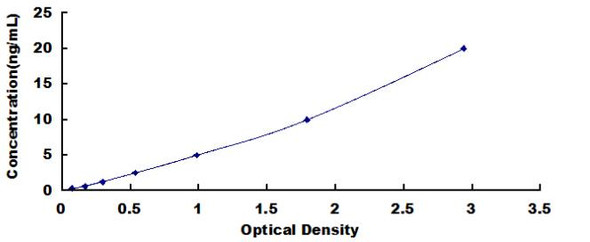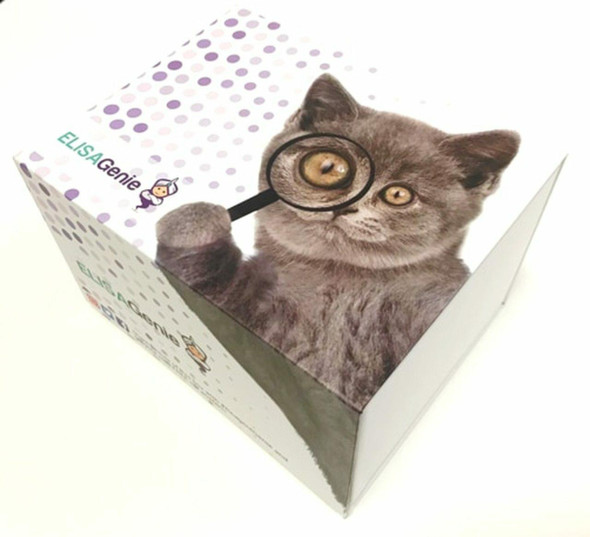Human Cell Biology ELISA Kits 4
Human D2R/DRD2 (Dopamine Receptor D2) CLIA Kit (HUES00698)
- SKU:
- HUES00698
- Product Type:
- ELISA Kit
- ELISA Type:
- CLIA Kit
- Size:
- 96 Assays
- Sensitivity:
- 37.5pg/mL
- Range:
- 62.5-4000pg/mL
- ELISA Type:
- Sandwich
- Reactivity:
- Human
- Sample Type:
- Serum, plasma and other biological fluids
- Research Area:
- Cell Biology
Description
| Assay type: | Sandwich |
| Format: | 96T |
| Assay time: | 4.5h |
| Reactivity: | Human |
| Detection method: | Chemiluminescence |
| Detection range: | 62.50-4000 pg/mL |
| Sensitivity: | 37.50 pg/mL |
| Sample volume: | 100µL |
| Sample type: | Serum, plasma and other biological fluids |
| Repeatability: | CV < 15% |
| Specificity: | This kit recognizes Human D2R/DRD2 in samples. No significant cross-reactivity or interference between Human D2R/DRD2 and analogues was observed. |
This kit uses Sandwich-CLIA as the method. The micro CLIA plate provided in this kit has been pre-coated with an antibody specific to Human D2R/DRD2. Standards or samples are added to the appropriate micro CLIA plate wells and combined with the specific antibody. Then a biotinylated detection antibody specific for Human D2R/DRD2 and Avidin-Horseradish Peroxidase (HRP) conjugate are added to each micro plate well successively and incubated. Free components are washed away. The substrate solution is added to each well. Only those wells that contain Human D2R/DRD2, biotinylated detection antibody and Avidin-HRP conjugate will appear fluorescence. The Relative light unit (RLU) value is measured spectrophotometrically by the Chemiluminescence immunoassay analyzer. The RLU value is positively associated with the concentration of Human D2R/DRD2. The concentration of Human D2R/DRD2 in the samples can be calculated by comparing the RLU of the samples to the standard curve.
| UniProt Protein Function: | DRD2: Dopamine receptor whose activity is mediated by G proteins which inhibit adenylyl cyclase. Defects in DRD2 are associated with dystonia type 11 (DYT11); also known as alcohol-responsive dystonia. DYT11 is a myoclonic dystonia. Dystonia is defined by the presence of sustained involuntary muscle contractions, often leading to abnormal postures. DYT11 is characterized by involuntary lightning jerks and dystonic movements and postures alleviated by alcohol. Inheritance is autosomal dominant. The age of onset, pattern of body involvement, presence of myoclonus and response to alcohol are all variable. Belongs to the G-protein coupled receptor 1 family. 3 isoforms of the human protein are produced by alternative splicing. |
| UniProt Protein Details: | Protein type:Receptor, GPCR; GPCR, family 1; Membrane protein, multi-pass; Membrane protein, integral Chromosomal Location of Human Ortholog: 11q23 Cellular Component: axon; dendrite; integral to plasma membrane; nonmotile primary cilium; plasma membrane; synaptic vesicle membrane Molecular Function:adrenoceptor activity; dopamine binding; dopamine D2 receptor-like receptor activity; drug binding; identical protein binding; protein binding Biological Process: adenohypophysis development; adult walking behavior; arachidonic acid secretion; associative learning; axonogenesis; behavioral response to cocaine; behavioral response to ethanol; branching morphogenesis of a nerve; cerebral cortex GABAergic interneuron migration; circadian regulation of gene expression; dopamine metabolic process; dopamine receptor, adenylate cyclase inhibiting pathway; dopamine receptor, phospholipase C activating pathway; locomotory behavior; negative regulation of blood pressure; negative regulation of cell migration; negative regulation of cell proliferation; negative regulation of dopamine receptor signaling pathway; negative regulation of protein kinase B signaling cascade; negative regulation of protein secretion; negative regulation of synaptic transmission, glutamatergic; nerve-nerve synaptic transmission; peristalsis; phosphatidylinositol metabolic process; positive regulation of cytokinesis; positive regulation of dopamine uptake; positive regulation of growth hormone secretion; positive regulation of neuroblast proliferation; prepulse inhibition; protein localization; reduction of cytosolic calcium ion concentration; regulation of cAMP metabolic process; regulation of dopamine secretion; regulation of dopamine uptake; regulation of heart rate; regulation of long-term neuronal synaptic plasticity; regulation of potassium ion transport; regulation of sodium ion transport; regulation of synaptic transmission, GABAergic; regulation of systemic arterial blood pressure by neurological process; release of sequestered calcium ion into cytosol; response to amphetamine; response to cocaine; response to drug; response to light stimulus; response to morphine; response to toxin; sensory perception of smell; synaptic transmission, dopaminergic; synaptogenesis; thermoregulation; visual learning Disease: Myoclonic Dystonia |
| NCBI Summary: | This gene encodes the D2 subtype of the dopamine receptor. This G-protein coupled receptor inhibits adenylyl cyclase activity. A missense mutation in this gene causes myoclonus dystonia; other mutations have been associated with schizophrenia. Alternative splicing of this gene results in two transcript variants encoding different isoforms. A third variant has been described, but it has not been determined whether this form is normal or due to aberrant splicing. [provided by RefSeq, Jul 2008] |
| UniProt Code: | P14416 |
| NCBI GenInfo Identifier: | 118206 |
| NCBI Gene ID: | 1813 |
| NCBI Accession: | P14416. 2 |
| UniProt Secondary Accession: | P14416,Q9NZR3, Q9UPA9, |
| UniProt Related Accession: | P14416 |
| Molecular Weight: | 50,847 Da |
| NCBI Full Name: | D(2) dopamine receptor |
| NCBI Synonym Full Names: | dopamine receptor D2 |
| NCBI Official Symbol: | DRD2 |
| NCBI Official Synonym Symbols: | D2R; D2DR |
| NCBI Protein Information: | D(2) dopamine receptor |
| UniProt Protein Name: | D(2) dopamine receptor |
| UniProt Synonym Protein Names: | Dopamine D2 receptor |
| Protein Family: | D(2) dopamine receptor |
| UniProt Gene Name: | DRD2 |
| UniProt Entry Name: | DRD2_HUMAN |
As the RLU values of the standard curve may vary according to the conditions of the actual assay performance (e. g. operator, pipetting technique, washing technique or temperature effects), the operator should establish a standard curve for each test. Typical standard curve and data is provided below for reference only.
| Concentration (pg/mL) | RLU | Average | Corrected |
| 4000 | 54614 63548 | 59081 | 59046 |
| 2000 | 27764 27954 | 27859 | 27824 |
| 1000 | 13848 13120 | 13484 | 13449 |
| 500 | 6393 6817 | 6605 | 6570 |
| 250 | 3349 3137 | 3243 | 3208 |
| 125 | 1629 1533 | 1581 | 1546 |
| 62.50 | 702 808 | 755 | 720 |
| 0 | 33 37 | 35 | -- |
Precision
Intra-assay Precision (Precision within an assay): 3 samples with low, mid range and high level Human D2R/DRD2 were tested 20 times on one plate, respectively.
Inter-assay Precision (Precision between assays): 3 samples with low, mid range and high level Human D2R/DRD2 were tested on 3 different plates, 20 replicates in each plate.
| Intra-assay Precision | Inter-assay Precision | |||||
| Sample | 1 | 2 | 3 | 1 | 2 | 3 |
| n | 20 | 20 | 20 | 20 | 20 | 20 |
| Mean (pg/mL) | 220.37 | 383.70 | 1849.86 | 228.19 | 396.74 | 1768.54 |
| Standard deviation | 20.34 | 36.53 | 204.41 | 24.12 | 46.78 | 188.17 |
| C V (%) | 9.23 | 9.52 | 11.05 | 10.57 | 11.79 | 10.64 |
Recovery
The recovery of Human D2R/DRD2 spiked at three different levels in samples throughout the range of the assay was evaluated in various matrices.
| Sample Type | Range (%) | Average Recovery (%) |
| Serum (n=5) | 98-111 | 103 |
| EDTA plasma (n=5) | 90-106 | 96 |
| Cell culture media (n=5) | 86-100 | 92 |
Linearity
Samples were spiked with high concentrations of Human D2R/DRD2 and diluted with Reference Standard & Sample Diluent to produce samples with values within the range of the assay.
| Serum (n=5) | EDTA plasma (n=5) | Cell culture media (n=5) | ||
| 1:2 | Range (%) | 84-98 | 94-112 | 88-101 |
| Average (%) | 90 | 102 | 95 | |
| 1:4 | Range (%) | 90-104 | 97-113 | 94-106 |
| Average (%) | 97 | 105 | 99 | |
| 1:8 | Range (%) | 99-116 | 90-102 | 93-105 |
| Average (%) | 107 | 96 | 99 | |
| 1:16 | Range (%) | 94-111 | 95-108 | 95-111 |
| Average (%) | 102 | 102 | 102 |
An unopened kit can be stored at 4°C for 1 month. If the kit is not used within 1 month, store the items separately according to the following conditions once the kit is received.
| Item | Specifications | Storage |
| Micro CLIA Plate(Dismountable) | 8 wells ×12 strips | -20°C, 6 months |
| Reference Standard | 2 vials | |
| Concentrated Biotinylated Detection Ab (100×) | 1 vial, 120 µL | |
| Concentrated HRP Conjugate (100×) | 1 vial, 120 µL | -20°C(shading light), 6 months |
| Reference Standard & Sample Diluent | 1 vial, 20 mL | 4°C, 6 months |
| Biotinylated Detection Ab Diluent | 1 vial, 14 mL | |
| HRP Conjugate Diluent | 1 vial, 14 mL | |
| Concentrated Wash Buffer (25×) | 1 vial, 30 mL | |
| Substrate Reagent A | 1 vial, 5 mL | 4°C (shading light) |
| Substrate Reagent B | 1 vial, 5 mL | 4°C (shading light) |
| Plate Sealer | 5 pieces | |
| Product Description | 1 copy | |
| Certificate of Analysis | 1 copy |
- Set standard, test sample and control (zero) wells on the pre-coated plate and record theirpositions. It is recommended to measure each standard and sample in duplicate. Note: addall solutions to the bottom of the plate wells while avoiding contact with the well walls. Ensuresolutions do not foam when adding to the wells.
- Aliquot 100µl of standard solutions into the standard wells.
- Add 100µl of Sample / Standard dilution buffer into the control (zero) well.
- Add 100µl of properly diluted sample (serum, plasma, tissue homogenates and otherbiological fluids. ) into test sample wells.
- Cover the plate with the sealer provided in the kit and incubate for 90 min at 37°C.
- Aspirate the liquid from each well, do not wash. Immediately add 100µL of BiotinylatedDetection Ab working solution to each well. Cover the plate with a plate seal and gently mix. Incubate for 1 hour at 37°C.
- Aspirate or decant the solution from the plate and add 350µL of wash buffer to each welland incubate for 1-2 minutes at room temperature. Aspirate the solution from each well andclap the plate on absorbent filter paper to dry. Repeat this process 3 times. Note: a microplatewasher can be used in this step and other wash steps.
- Add 100µL of HRP Conjugate working solution to each well. Cover with a plate seal andincubate for 30 min at 37°C.
- Aspirate or decant the solution from each well. Repeat the wash process for five times asconducted in step 7.
- Add 100µL of Substrate mixture solution to each well. Cover with a new plate seal andincubate for no more than 5 min at 37°C. Protect the plate from light.
- Determine the RLU value of each well immediately.






